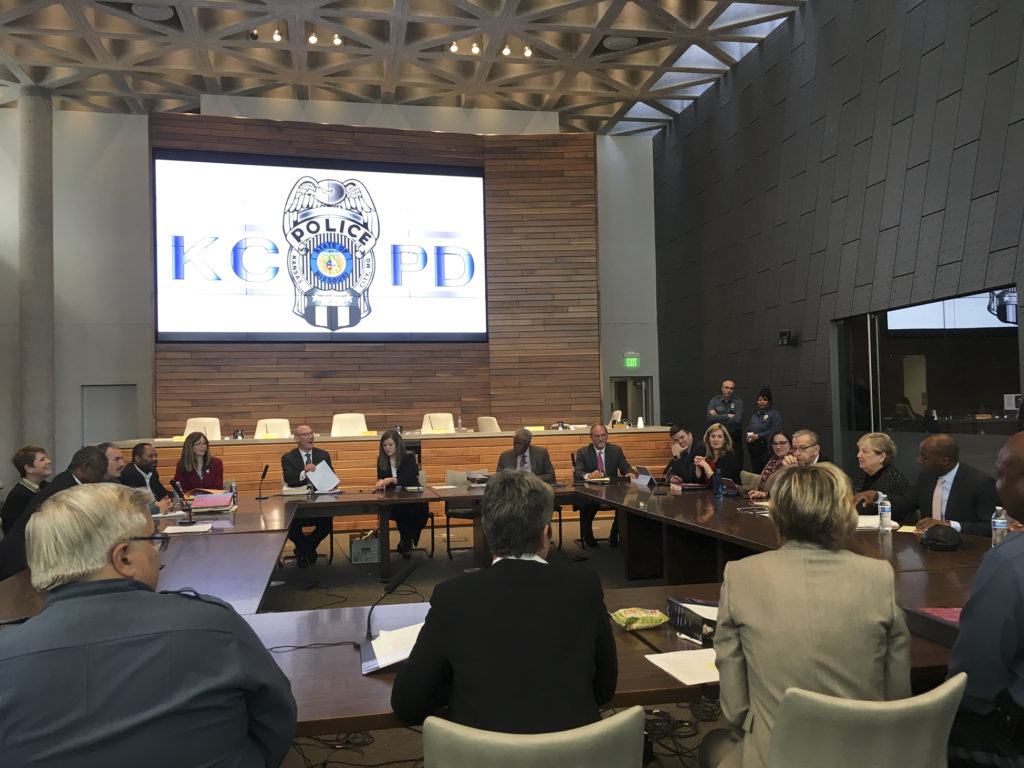Northeast News
February 14, 2017
KANSAS CITY, Missouri – The lines of communication between City Hall and the KCPD headquarters across the street reopened in an official capacity on Tuesday, February 14, as the Board of Police Commissioners conducted a rare special meeting with the KCMO City Council.
The meeting, which has been months in the making, was an opportunity for the Board of Police Commissioners to clear the air and open up a dialogue about issues throughout the city. 2nd District Councilwoman Teresa Loar was a driving factor in arranging the meeting of the two groups. Loar began the meeting by pointing out that during her previous tenure on City Council – from 1995 until 2003 – meetings with the Board of Police Commissioners were a regular occurrence.
3rd District Councilman Quinton Lucas began the conversation in earnest by addressing the city’s rising homicide rate. According to KCPD, Kansas City, Missouri saw 100 homicides in 2013, before decreasing to 82 homicides in 2014. In 2015, however, the number of homicides spiked to reach 111. In 2016, Kansas City, Missouri saw 128 homicides. KCPD’s Daily Homicide Analysis shows that 16 homicides have already been recorded in 2017.
Lucas noted that he often hears from his constituents about two main issues: violent crime in the district, and the feeling that too many resources are being spent on police department administrators.
“There’s not a 3rd District meeting that goes on where people don’t talk to us about homicides and violent crime in Kansas City,” said Lucas.
KCPD representatives responded that while the number of Sergeants at the department has increased from 227 in 2009 to 247 in 2017, the number of command-level staff has remained relatively steady. In 2009, there were 78 KCPD Commanders; in 2017, there are 79.
As for the city’s homicide rate, Mayor Sly James responded that the Kansas City No Violence Alliance (KC NoVA) is working to change the culture of the police department as well as that of the city at large. James praised KCPD Chief of Police Darryl Forte for implementing NoVA into the fabric of the department.
“Since its advent, it has required some internal realignment of the police department,” said James. “It is difficult, I think, to change the culture of any organization, but he has done that.”
James also made the argument that the rise in homicides throughout the city is not necessarily related to group violence, saying that a lot of the violent incidents are “one-off” events unrelated to any kind of organized criminal element. To that point, KCPD records show that in 2014, only 18 homicides were motivated by an argument, while four listed domestic violence as a motive. In 2015, 30 homicides were the result of an argument, and 15 listed domestic violence as a motive. The figures for 2016 remained elevated, with 29 homicides a result of an argument and 14 listing domestic violence as a motive.
Forte also defended the KC NoVA program, saying that too often the answer to crime in this country has been mass incarceration. Forte added that it’s program’s like NoVA that are helping to change the negative perception of police officers in Kansas City.
“I think that helps us when something goes wrong with police or other segments of the community,” said Forte. “I don’t know how to measure that in dollars, but that’s a benefit of having KC NoVA.”
Commissioner Alvin Brooks – a former KCMO police officer (1954-1964), Assistant City Manager (1984-1991), and two-term City Councilman (elected 1999 and 2003) – spoke to the positive changes he’s seen from police department during his lifetime. Speaking of his time on the police force, Brooks discussed a time of significant corruption. He added that KCPD has cleaned up considerably since then, noting that the role of police officers continues to evolve beyond the typical duties once expected of them.
“He or she is a lawyer, a social worker, all of these other things that aren’t part of their job description,” said Brooks.
Forte and Brooks also agreed that the city needs to prioritize clean-up efforts throughout the city. Both cited a connection between the mentality of violence in an individual and what their neighborhood looks like when they walk out the door. Forte added that the City needs to get creative about how to get others engaged, and that neighbors “need to take their own blocks back.”
Though another concrete meeting time wasn’t arranged on Feb. 14, all sides expressed a willingness to get together with more regularity in the future. A KCPD staffing study city leaders are relying on to guide department-related decisions moving forward is expected to be completed sometime this spring.

















